The Cambridge History of Japan, Vol. 3: Medieval Japan
Подождите немного. Документ загружается.

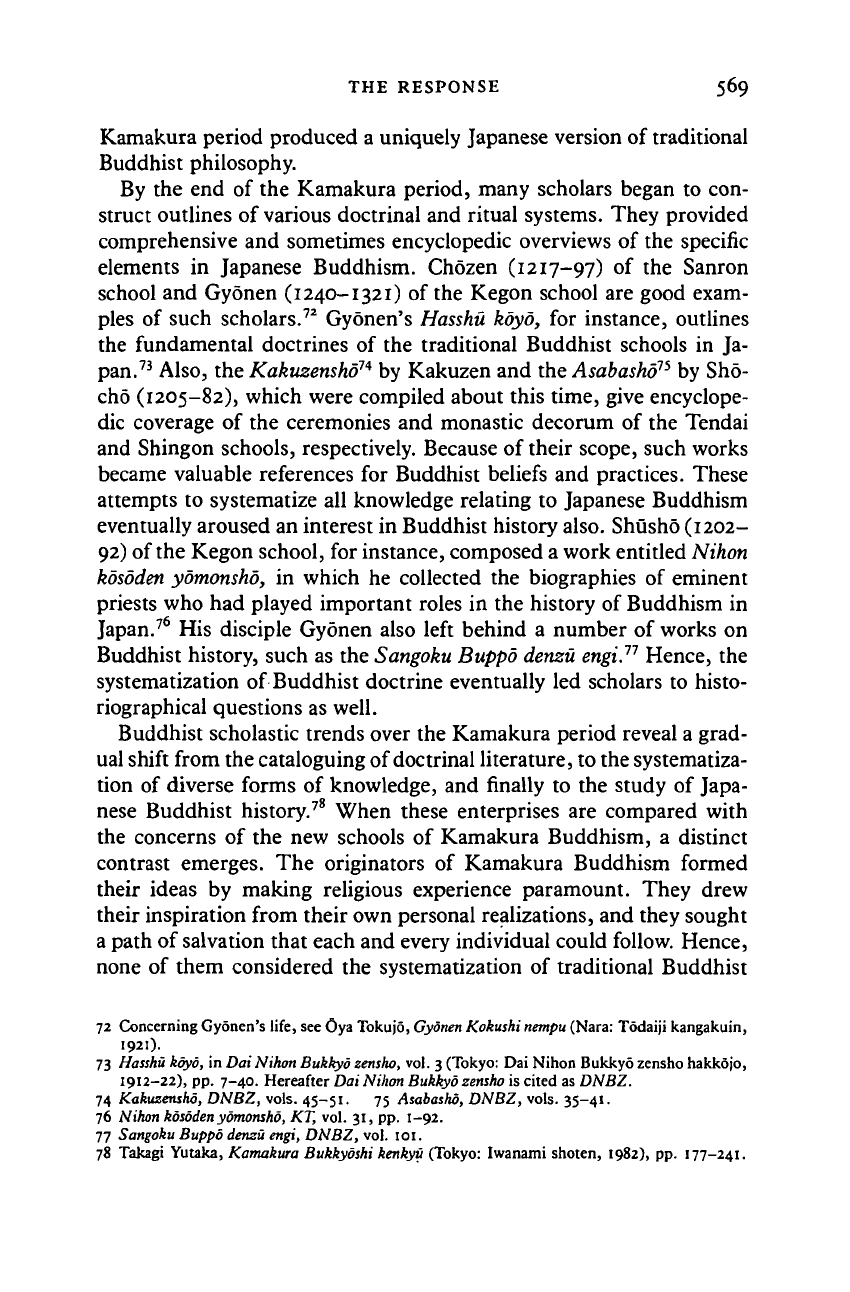
THE RESPONSE 569
Kamakura period produced a uniquely Japanese version of traditional
Buddhist philosophy.
By the end of the Kamakura period, many scholars began to con-
struct outlines of various doctrinal and ritual systems. They provided
comprehensive and sometimes encyclopedic overviews of the specific
elements in Japanese Buddhism. Chozen (1217-97) of the Sanron
school and Gyonen (1240-1321) of the Kegon school are good exam-
ples of such scholars.
72
Gyonen's Hasshu koyo, for instance, outlines
the fundamental doctrines of the traditional Buddhist schools in Ja-
pan.
73
Also, the Kakuzensho
74
by Kakuzen and the Asabasho
!i
by Sho-
cho (1205-82), which were compiled about this time, give encyclope-
dic coverage of the ceremonies and monastic decorum of the Tendai
and Shingon schools, respectively. Because of their scope, such works
became valuable references for Buddhist beliefs and practices. These
attempts to systematize all knowledge relating to Japanese Buddhism
eventually aroused an interest in Buddhist history also. Shusho (1202-
92) of the Kegon school, for instance, composed a work entitled Nihon
kosoden
yomonsho, in which he collected the biographies of eminent
priests who had played important roles in the history of Buddhism in
Japan.
76
His disciple Gyonen also left behind a number of works on
Buddhist history, such as the Sangoku Buppo denzu engi.
77
Hence, the
systematization of Buddhist doctrine eventually led scholars to histo-
riographical questions as well.
Buddhist scholastic trends over the Kamakura period reveal a grad-
ual shift from the cataloguing of doctrinal literature, to the systematiza-
tion of diverse forms of knowledge, and finally to the study of Japa-
nese Buddhist history.
78
When these enterprises are compared with
the concerns of the new schools of Kamakura Buddhism, a distinct
contrast emerges. The originators of Kamakura Buddhism formed
their ideas by making religious experience paramount. They drew
their inspiration from their own personal realizations, and they sought
a path of salvation that each and every individual could follow. Hence,
none of them considered the systematization of traditional Buddhist
72 Concerning Gyonen's life, see Oya Tokujo, Gyonen Kokushi nempu (Nara: Todaiji kangakuin,
1921).
73 Hasshu koyo, in Dai Nihon Bukkyo
zensho,
vol. 3 (Tokyo: Dai Nihon Bukkyo zensho hakkojo,
1912-22), pp. 7-40. Hereafter Dai Nihon Bukkyo zensho is cited as DNBZ.
74 Kakuzensho, DNBZ, vols.
45-51.
75 Asabasho, DNBZ, vols.
35-41.
76 Nihon
kosoden
yomonsho, KT, vol. 31, pp. 1-92.
77 Sangoku Buppo denzu engi, DNBZ, vol. 101.
78 Takagi Yutaka, Kamakura Bukkyoshi kenkyu (Tokyo: Iwanami shoten, 1982), pp.
177-241.
Cambridge Histories Online © Cambridge University Press, 2008
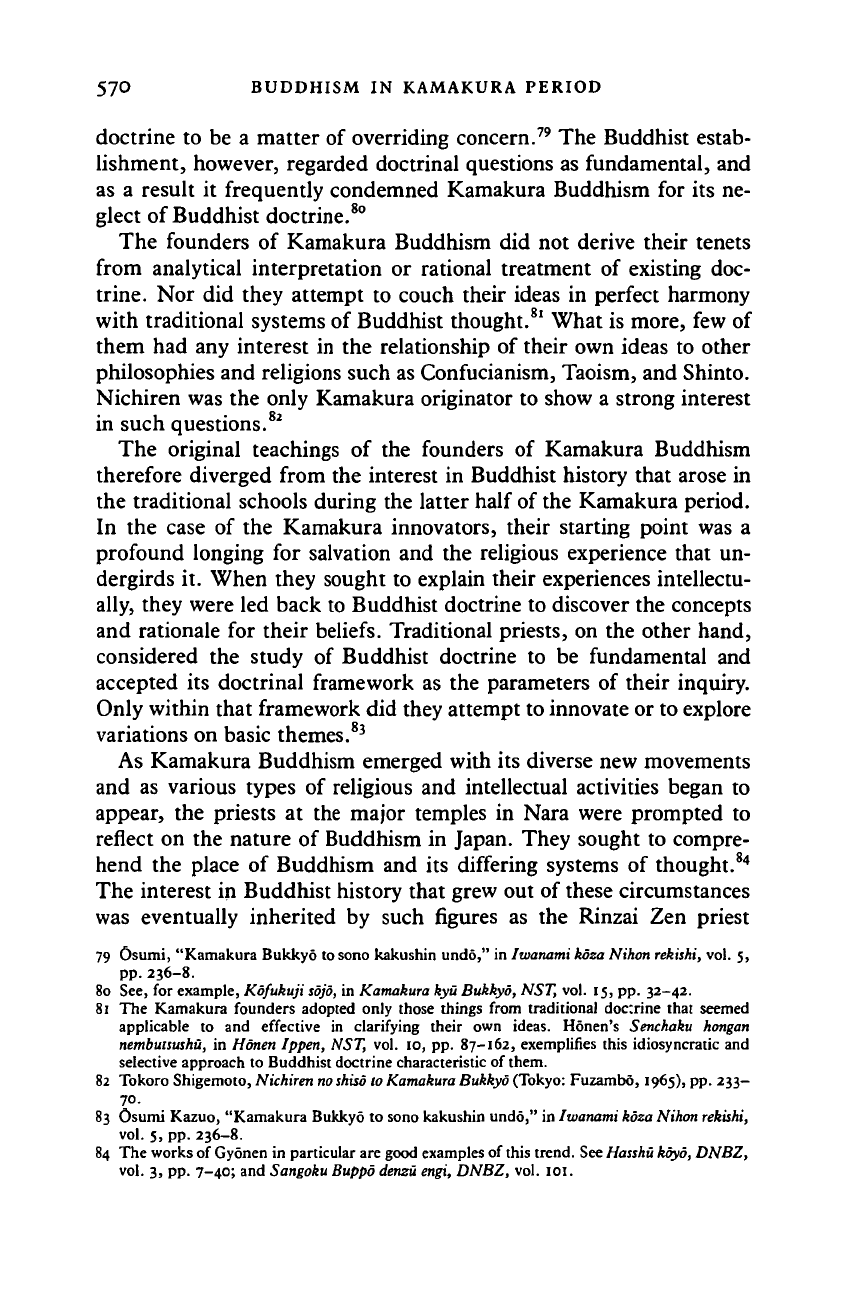
57° BUDDHISM IN KAMAKURA PERIOD
doctrine to be a matter of overriding concern.
79
The Buddhist estab-
lishment, however, regarded doctrinal questions as fundamental, and
as a result it frequently condemned Kamakura Buddhism for its ne-
glect of Buddhist doctrine.
80
The founders of Kamakura Buddhism did not derive their tenets
from analytical interpretation or rational treatment of existing doc-
trine.
Nor did they attempt to couch their ideas in perfect harmony
with traditional systems of Buddhist thought.
81
What is more, few of
them had any interest in the relationship of their own ideas to other
philosophies and religions such as Confucianism, Taoism, and Shinto.
Nichiren was the only Kamakura originator to show a strong interest
in such questions.
82
The original teachings of the founders of Kamakura Buddhism
therefore diverged from the interest in Buddhist history that arose in
the traditional schools during the latter half of the Kamakura period.
In the case of the Kamakura innovators, their starting point was a
profound longing for salvation and the religious experience that un-
dergirds it. When they sought to explain their experiences intellectu-
ally, they were led back to Buddhist doctrine to discover the concepts
and rationale for their beliefs. Traditional priests, on the other hand,
considered the study of Buddhist doctrine to be fundamental and
accepted its doctrinal framework as the parameters of their inquiry.
Only within that framework did they attempt to innovate or to explore
variations on basic themes.
83
As Kamakura Buddhism emerged with its diverse new movements
and as various types of religious and intellectual activities began to
appear, the priests at the major temples in Nara were prompted to
reflect on the nature of Buddhism in Japan. They sought to compre-
hend the place of Buddhism and its differing systems of thought.
84
The interest in Buddhist history that grew out of these circumstances
was eventually inherited by such figures as the Rinzai Zen priest
79 Osumi, "Kamakura Bukkyo to sono kakushin undo," in Iwanami koza Nihon
rekishi,
vol. 5,
pp.
236-8.
80 See, for example, Kofukuji
sdjo,
in Kamakura kyu Bukkyo, NST, vol. 15, pp. 32-42.
Si The Kamakura founders adopted only those things from traditional doctrine that seemed
applicable to and effective in clarifying their own ideas. Honen's Senchaku hongan
nembutsushu,
in Honen Ippen, NST, vol. 10, pp. 87-162, exemplifies this idiosyncratic and
selective approach to Buddhist doctrine characteristic of them.
82 Tokoro Shigemoto, Nichiren
no shiso
to Kamakura Bukkyo
(Tokyo:
Fuzambo, 1965), pp. 233-
70.
83 Osumi Kazuo, "Kamakura Bukkyo to sono kakushin undo," in Iwanami koza Nihon
rekishi,
vol. 5, pp. 236-8.
84 The works of Gyonen in particular are good examples of this trend. See
Hasshu
koyo, DNBZ,
vol. 3, pp. 7-40; and Sangoku Buppo denzu
engi,
DNBZ, vol. 101.
Cambridge Histories Online © Cambridge University Press, 2008
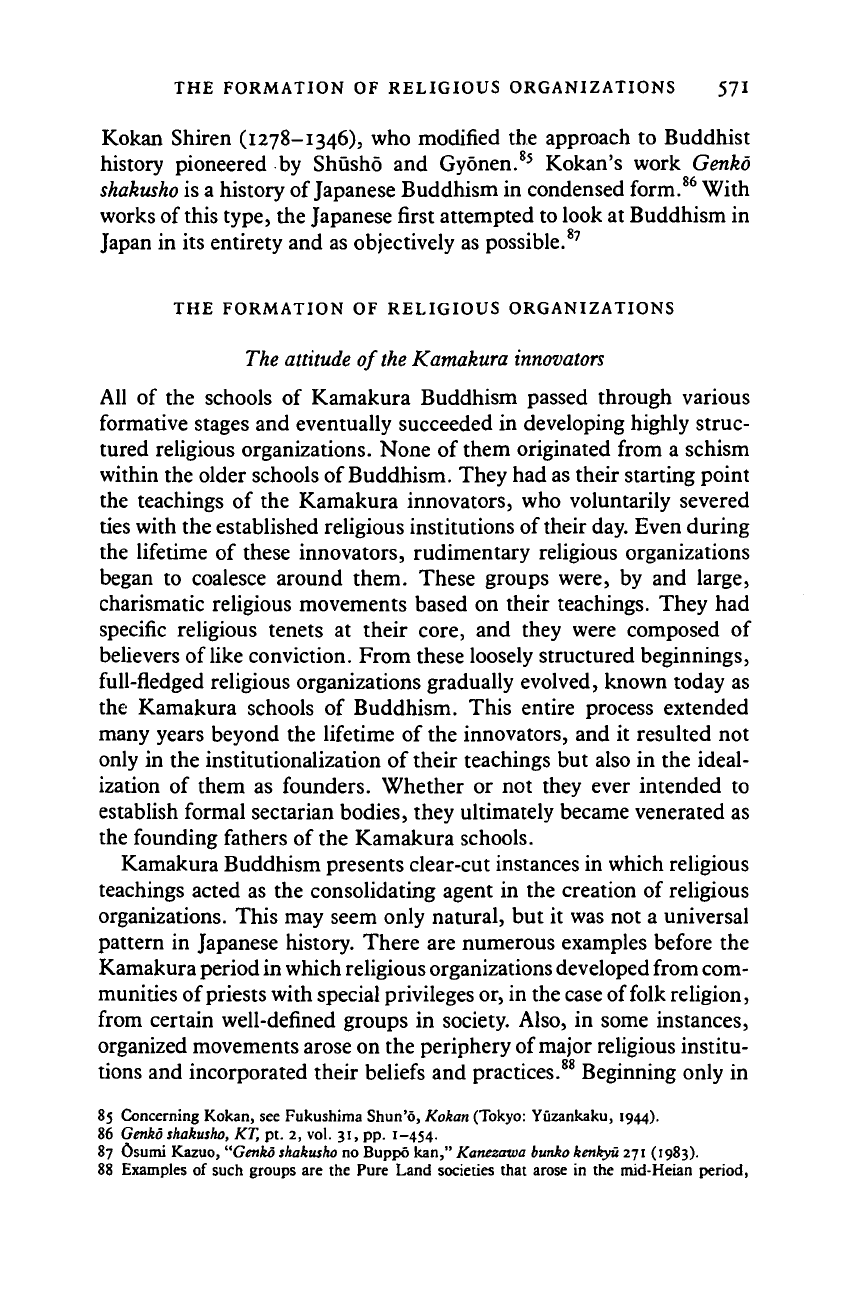
THE FORMATION OF RELIGIOUS ORGANIZATIONS 57I
Kokan Shiren (1278-1346), who modified the approach to Buddhist
history pioneered by Shusho and Gyonen.
85
Kokan's work Genko
skakusho is a history of Japanese Buddhism in condensed form.
86
With
works of this type, the Japanese first attempted to look at Buddhism in
Japan in its entirety and as objectively as possible.
87
THE FORMATION OF RELIGIOUS ORGANIZATIONS
The attitude of
the
Kamakura innovators
All of the schools of Kamakura Buddhism passed through various
formative stages and eventually succeeded in developing highly struc-
tured religious organizations. None of them originated from a schism
within the older schools of Buddhism. They had as their starting point
the teachings of the Kamakura innovators, who voluntarily severed
ties with the established religious institutions of their day. Even during
the lifetime of these innovators, rudimentary religious organizations
began to coalesce around them. These groups were, by and large,
charismatic religious movements based on their teachings. They had
specific religious tenets at their core, and they were composed of
believers of like conviction. From these loosely structured beginnings,
full-fledged religious organizations gradually evolved, known today as
the Kamakura schools of Buddhism. This entire process extended
many years beyond the lifetime of the innovators, and it resulted not
only in the institutionalization of their teachings but also in the ideal-
ization of them as founders. Whether or not they ever intended to
establish formal sectarian bodies, they ultimately became venerated as
the founding fathers of the Kamakura schools.
Kamakura Buddhism presents clear-cut instances in which religious
teachings acted as the consolidating agent in the creation of religious
organizations. This may seem only natural, but it was not a universal
pattern in Japanese history. There are numerous examples before the
Kamakura period in which religious organizations developed from com-
munities of priests with special privileges or, in the case of folk religion,
from certain well-defined groups in society. Also, in some instances,
organized movements arose on the periphery of major religious institu-
tions and incorporated their beliefs and practices.
88
Beginning only in
85 Concerning Kokan, see Fukushima Shun'6, Kokan (Tokyo: Yuzankaku, 1944).
86 Genko shakusko, KT, pt. 2, vol. 31, pp.
1-454.
87 Osumi Kazuo, "Genko shakusho no Buppo kan," Kanezawa bunko kenkyu 271 (1983).
88 Examples of such groups are the Pure Land societies that arose in the mid-Heian period,
Cambridge Histories Online © Cambridge University Press, 2008
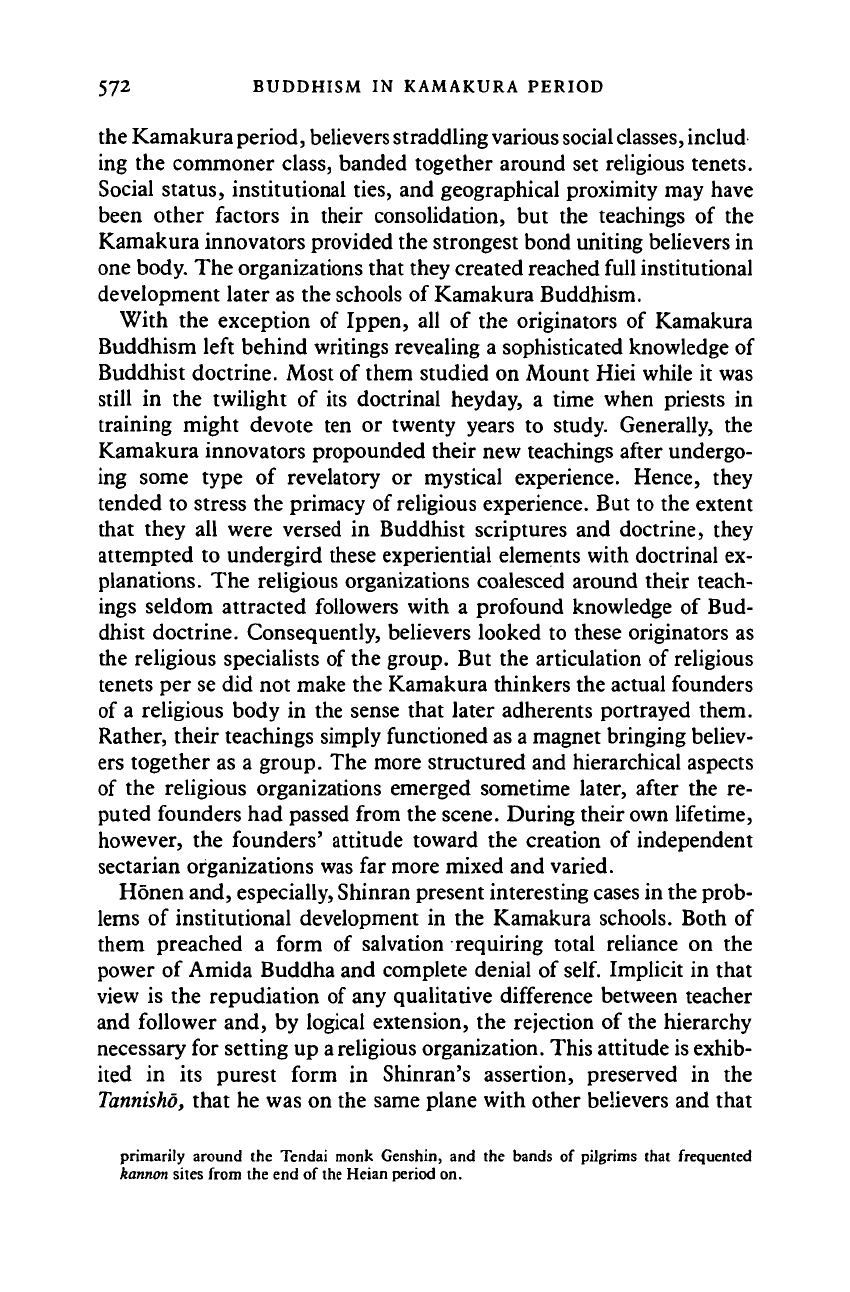
572 BUDDHISM IN KAMAKURA PERIOD
the Kamakura period,
believers
straddling
various social
classes,
includ
ing the commoner class, banded together around set religious tenets.
Social status, institutional ties, and geographical proximity may have
been other factors in their consolidation, but the teachings of the
Kamakura innovators provided the strongest bond uniting believers in
one body. The organizations that they created reached full institutional
development later as the schools of Kamakura Buddhism.
With the exception of Ippen, all of the originators of Kamakura
Buddhism left behind writings revealing a sophisticated knowledge of
Buddhist doctrine. Most of them studied on Mount Hiei while it was
still in the twilight of its doctrinal heyday, a time when priests in
training might devote ten or twenty years to study. Generally, the
Kamakura innovators propounded their new teachings after undergo-
ing some type of revelatory or mystical experience. Hence, they
tended to stress the primacy of religious experience. But to the extent
that they all were versed in Buddhist scriptures and doctrine, they
attempted to undergird these experiential elements with doctrinal ex-
planations. The religious organizations coalesced around their teach-
ings seldom attracted followers with a profound knowledge of Bud-
dhist doctrine. Consequently, believers looked to these originators as
the religious specialists of the group. But the articulation of religious
tenets per se did not make the Kamakura thinkers the actual founders
of a religious body in the sense that later adherents portrayed them.
Rather, their teachings simply functioned as a magnet bringing believ-
ers together as a group. The more structured and hierarchical aspects
of the religious organizations emerged sometime later, after the re-
puted founders had passed from the scene. During their own lifetime,
however, the founders' attitude toward the creation of independent
sectarian organizations was far more mixed and varied.
Honen and, especially, Shinran present interesting cases in the prob-
lems of institutional development in the Kamakura schools. Both of
them preached a form of salvation requiring total reliance on the
power of Amida Buddha and complete denial of
self.
Implicit in that
view is the repudiation of any qualitative difference between teacher
and follower and, by logical extension, the rejection of the hierarchy
necessary for setting up
a
religious organization. This attitude is exhib-
ited in its purest form in Shinran's assertion, preserved in the
Tannisho,
that he was on the same plane with other believers and that
primarily around the Tendai monk Genshin, and the bands of pilgrims that frequented
kannon sites from the end of the Heian period on.
Cambridge Histories Online © Cambridge University Press, 2008
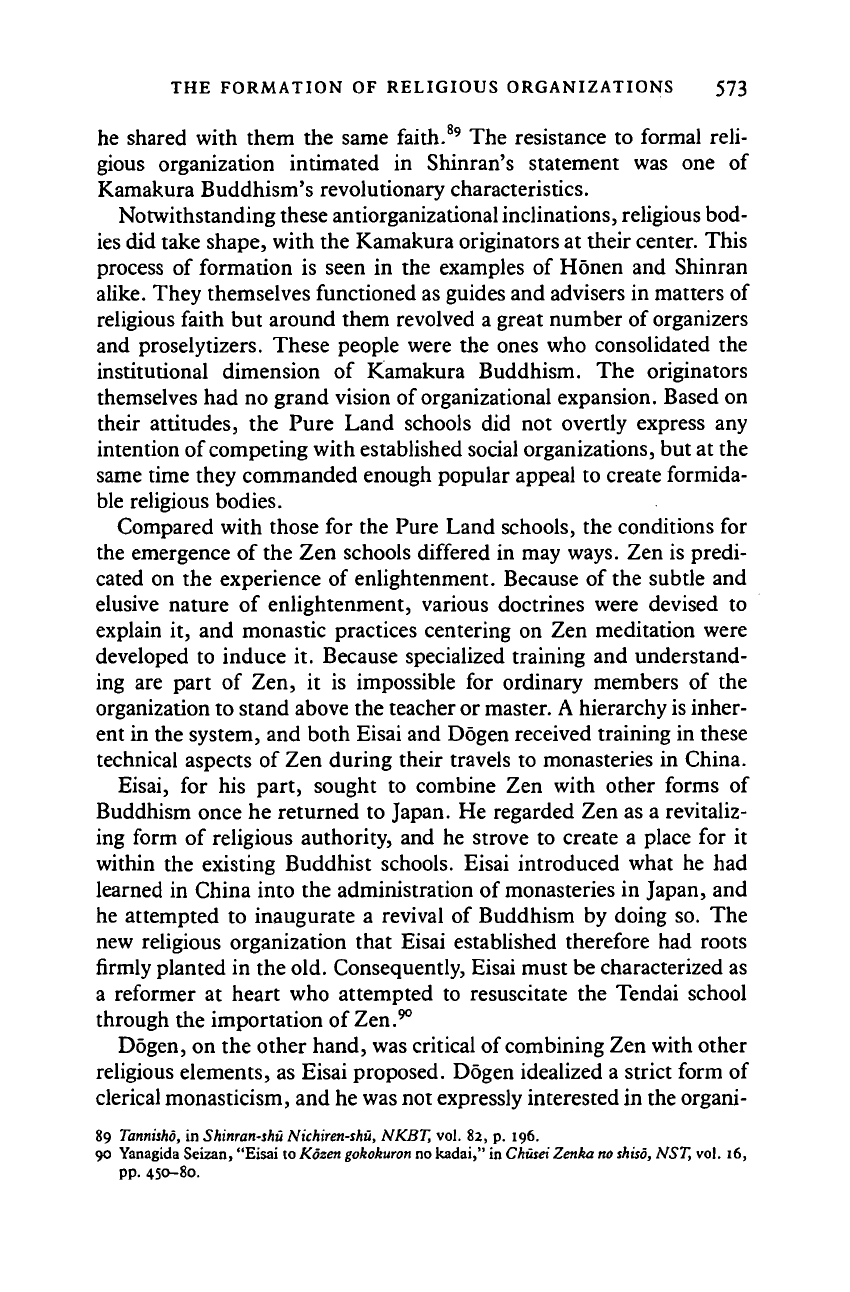
THE FORMATION OF RELIGIOUS ORGANIZATIONS 573
he shared with them the same faith.
89
The resistance to formal reli-
gious organization intimated in Shinran's statement was one of
Kamakura Buddhism's revolutionary characteristics.
Notwithstanding these antiorganizational inclinations, religious bod-
ies did take shape, with the Kamakura originators at their center. This
process of formation is seen in the examples of Honen and Shinran
alike. They themselves functioned as guides and advisers in matters of
religious faith but around them revolved a great number of organizers
and proselytizers. These people were the ones who consolidated the
institutional dimension of Kamakura Buddhism. The originators
themselves had no grand vision of organizational expansion. Based on
their attitudes, the Pure Land schools did not overtly express any
intention of competing with established social organizations, but at the
same time they commanded enough popular appeal to create formida-
ble religious bodies.
Compared with those for the Pure Land schools, the conditions for
the emergence of the Zen schools differed in may ways. Zen is predi-
cated on the experience of enlightenment. Because of the subtle and
elusive nature of enlightenment, various doctrines were devised to
explain it, and monastic practices centering on Zen meditation were
developed to induce it. Because specialized training and understand-
ing are part of Zen, it is impossible for ordinary members of the
organization to stand above the teacher or master. A hierarchy is inher-
ent in the system, and both Eisai and Dogen received training in these
technical aspects of Zen during their travels to monasteries in China.
Eisai, for his part, sought to combine Zen with other forms of
Buddhism once he returned to Japan. He regarded Zen as a revitaliz-
ing form of religious authority, and he strove to create a place for it
within the existing Buddhist schools. Eisai introduced what he had
learned in China into the administration of monasteries in Japan, and
he attempted to inaugurate a revival of Buddhism by doing so. The
new religious organization that Eisai established therefore had roots
firmly planted in the old. Consequently, Eisai must be characterized as
a reformer at heart who attempted to resuscitate the Tendai school
through the importation of Zen.
90
Dogen, on the other hand, was critical of combining Zen with other
religious elements, as Eisai proposed. Dogen idealized a strict form of
clerical monasticism, and he was not expressly interested in the organi-
89 Tannisho, in Shinran-shu Nichiren-shu,
NKBT,
vol. 82, p. 196.
90 Yanagida Seizan, "Eisai to Kozengokokuron no kadai," in ChuseiZenka no
shiso,
NST, vol. 16,
pp.
450-80.
Cambridge Histories Online © Cambridge University Press, 2008
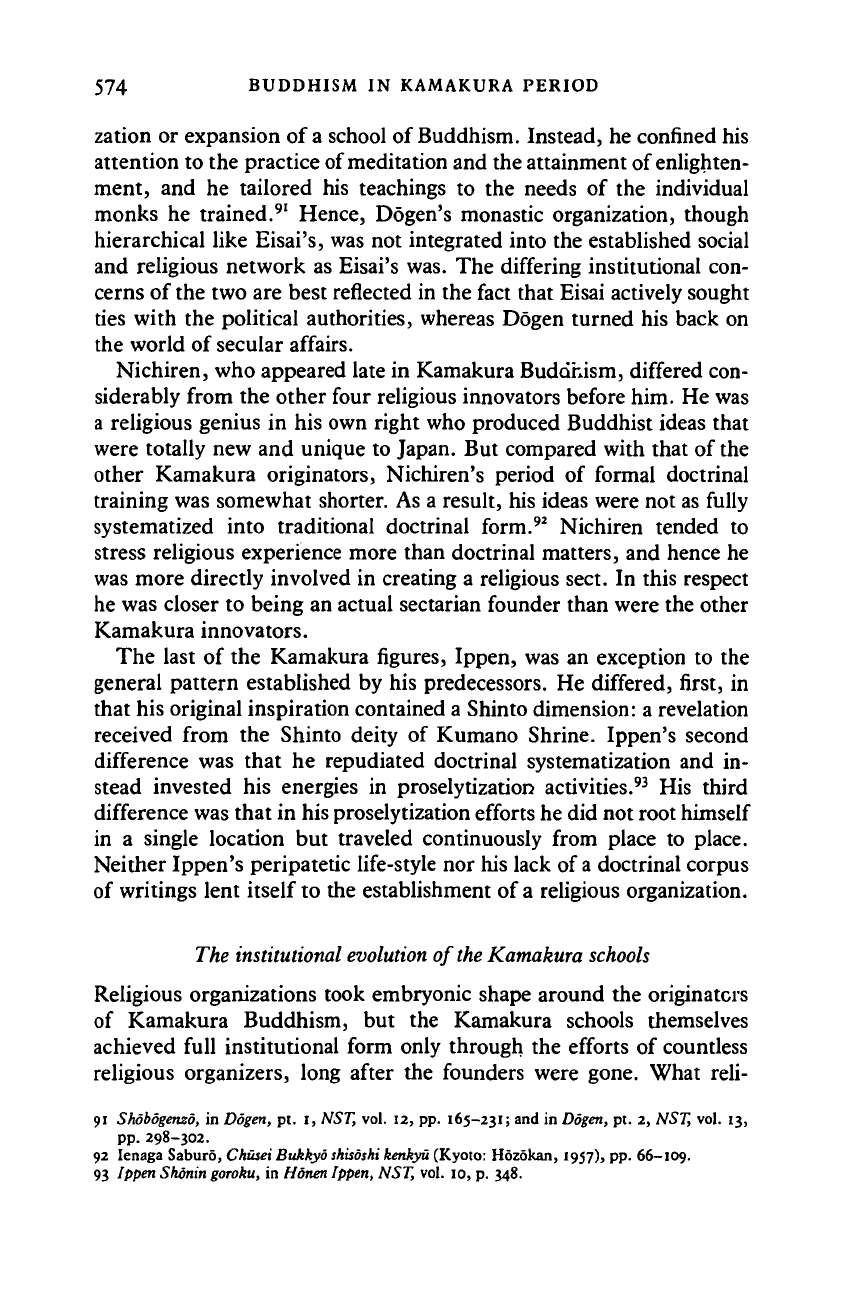
574 BUDDHISM IN KAMAKURA PERIOD
zation or expansion of
a
school of Buddhism. Instead, he confined his
attention to the practice of meditation and the attainment of enlighten-
ment, and he tailored his teachings to the needs of the individual
monks he trained.
91
Hence, Dogen's monastic organization, though
hierarchical like Eisai's, was not integrated into the established social
and religious network as Eisai's was. The differing institutional con-
cerns of the two are best reflected in the fact that Eisai actively sought
ties with the political authorities, whereas Dogen turned his back on
the world of secular affairs.
Nichiren, who appeared late in Kamakura Buddhism, differed con-
siderably from the other four religious innovators before him. He was
a religious genius in his own right who produced Buddhist ideas that
were totally new and unique to Japan. But compared with that of the
other Kamakura originators, Nichiren's period of formal doctrinal
training was somewhat shorter. As a result, his ideas were not as fully
systematized into traditional doctrinal form.
92
Nichiren tended to
stress religious experience more than doctrinal matters, and hence he
was more directly involved in creating a religious sect. In this respect
he was closer to being an actual sectarian founder than were the other
Kamakura innovators.
The last of the Kamakura figures, Ippen, was an exception to the
general pattern established by his predecessors. He differed, first, in
that his original inspiration contained a Shinto dimension: a revelation
received from the Shinto deity of Kumano Shrine. Ippen's second
difference was that he repudiated doctrinal systematization and in-
stead invested his energies in proselytization activities.
93
His third
difference was that in his proselytization efforts he did not root himself
in a single location but traveled continuously from place to place.
Neither Ippen's peripatetic life-style nor his lack of
a
doctrinal corpus
of writings lent itself to the establishment of
a
religious organization.
The institutional evolution of
the
Kamakura
schools
Religious organizations took embryonic shape around the originators
of Kamakura Buddhism, but the Kamakura schools themselves
achieved full institutional form only through the efforts of countless
religious organizers, long after the founders were gone. What reli-
91 Shobogenzo, in Dogen, pt. I, NST, vol. 12, pp. 165-231; and in Dogen, pt. 2, NST, vol. 13,
pp.
298-302.
92 Ienaga Saburo, Chusei Bukkyo
shisoshi kenkyu
(Kyoto: Hozokan, 1957), pp. 66-109.
93 Ippen Shonin
goroku,
in Honen Ippen, NST, vol. io, p. 348.
Cambridge Histories Online © Cambridge University Press, 2008
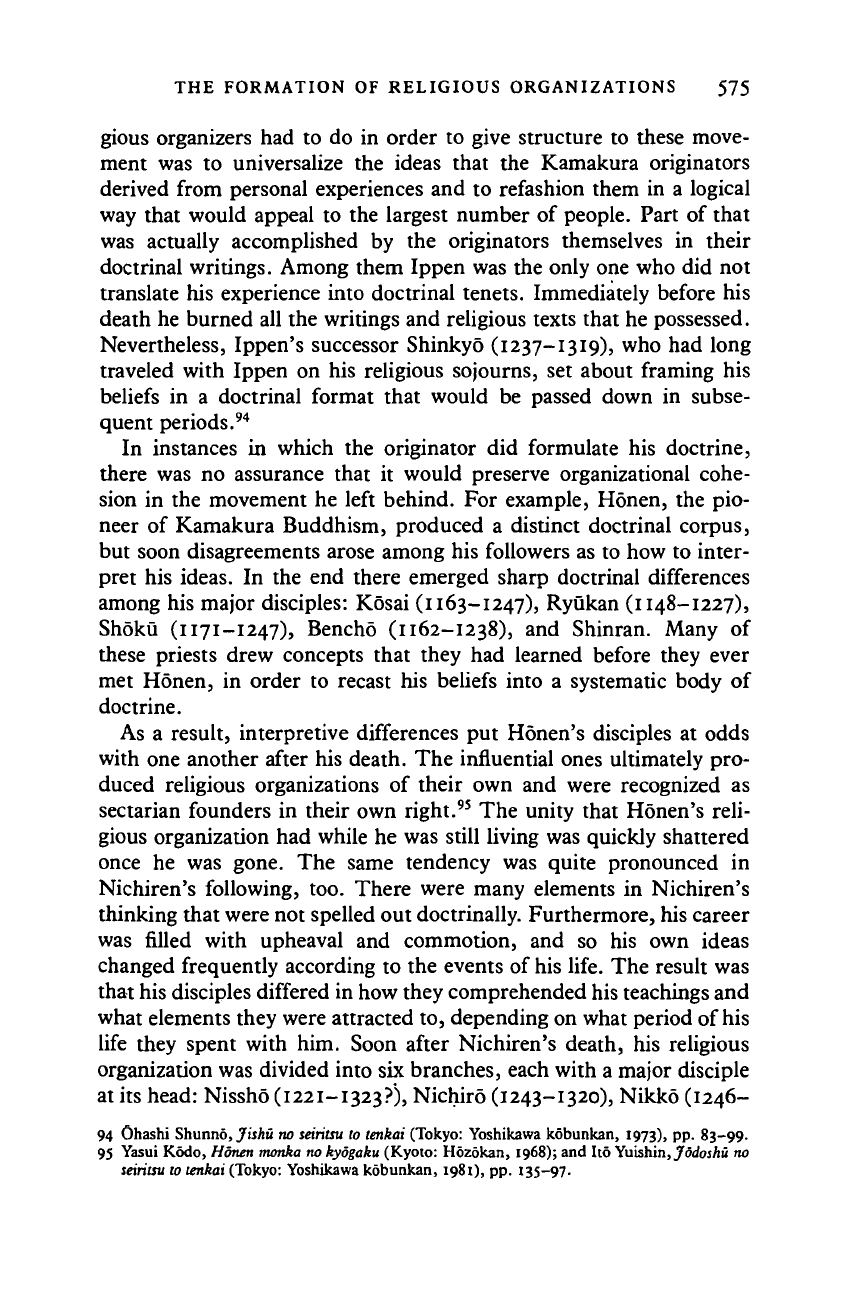
THE FORMATION OF RELIGIOUS ORGANIZATIONS 575
gious organizers had to do in order to give structure to these move-
ment was to universalize the ideas that the Kamakura originators
derived from personal experiences and to refashion them in a logical
way that would appeal to the largest number of people. Part of that
was actually accomplished by the originators themselves in their
doctrinal writings. Among them Ippen was the only one who did not
translate his experience into doctrinal tenets. Immediately before his
death he burned all the writings and religious texts that he possessed.
Nevertheless, Ippen's successor Shinkyo (1237-1319), who had long
traveled with Ippen on his religious sojourns, set about framing his
beliefs in a doctrinal format that would be passed down in subse-
quent periods.
94
In instances in which the originator did formulate his doctrine,
there was no assurance that it would preserve organizational cohe-
sion in the movement he left behind. For example, Honen, the pio-
neer of Kamakura Buddhism, produced a distinct doctrinal corpus,
but soon disagreements arose among his followers as to how to inter-
pret his ideas. In the end there emerged sharp doctrinal differences
among his major disciples: Kosai (1163-1247), Ryukan (1148-1227),
Shoku (1171-1247), Bencho (1162-1238), and Shinran. Many of
these priests drew concepts that they had learned before they ever
met Honen, in order to recast his beliefs into a systematic body of
doctrine.
As a result, interpretive differences put Honen's disciples at odds
with one another after his death. The influential ones ultimately pro-
duced religious organizations of their own and were recognized as
sectarian founders in their own right.
95
The unity that Honen's reli-
gious organization had while he was still living was quickly shattered
once he was gone. The same tendency was quite pronounced in
Nichiren's following, too. There were many elements in Nichiren's
thinking that were not spelled out doctrinally. Furthermore, his career
was filled with upheaval and commotion, and so his own ideas
changed frequently according to the events of his life. The result was
that his disciples differed in how they comprehended his teachings and
what elements they were attracted to, depending on what period of his
life they spent with him. Soon after Nichiren's death, his religious
organization was divided into six branches, each with a major disciple
at its head: Nissho (1221-1323?), Nichiro (1243-1320), Nikko (1246-
94 Ohashi Shunno, Jishu no
seiritsu
to tenkai (Tokyo: Yoshikawa kobunkan, 1973), pp. 83-99.
95 Yasui Kodo, Honen monka no
kyogaku
(Kyoto: Hozokan, 1968); and ltd
Yuishin,
Jodoshii
no
seiritsu
to tenkai (Tokyo: Yoshikawa kobunkan, 1981), pp. 135-97.
Cambridge Histories Online © Cambridge University Press, 2008
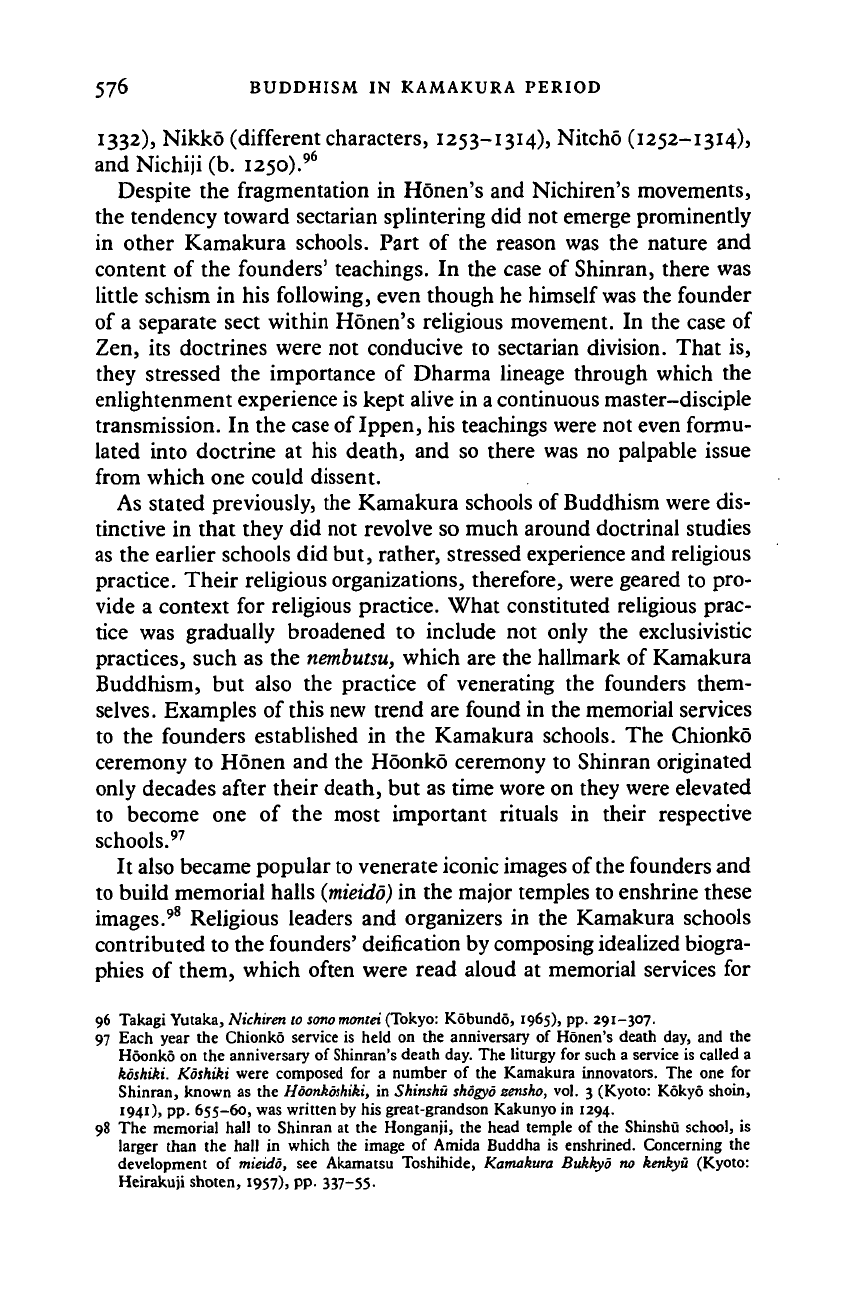
576 BUDDHISM IN KAMAKURA PERIOD
1332),
Nikko (different characters, 1253-1314), Nitcho (1252-1314),
and Nichiji (b. 1250).
96
Despite the fragmentation in Honen's and Nichiren's movements,
the tendency toward sectarian splintering did not emerge prominently
in other Kamakura schools. Part of the reason was the nature and
content of the founders' teachings. In the case of Shinran, there was
little schism in his following, even though he himself
was
the founder
of a separate sect within Honen's religious movement. In the case of
Zen, its doctrines were not conducive to sectarian division. That is,
they stressed the importance of Dharma lineage through which the
enlightenment experience is kept alive in
a
continuous master-disciple
transmission. In the case of Ippen, his teachings were not even formu-
lated into doctrine at his death, and so there was no palpable issue
from which one could dissent.
As stated previously, the Kamakura schools of Buddhism were dis-
tinctive in that they did not revolve so much around doctrinal studies
as the earlier schools did but, rather, stressed experience and religious
practice. Their religious organizations, therefore, were geared to pro-
vide a context for religious practice. What constituted religious prac-
tice was gradually broadened to include not only the exclusivistic
practices, such as the
nembutsu,
which are the hallmark of Kamakura
Buddhism, but also the practice of venerating the founders them-
selves. Examples of this new trend are found in the memorial services
to the founders established in the Kamakura schools. The Chionko
ceremony to Honen and the Hoonko ceremony to Shinran originated
only decades after their death, but as time wore on they were elevated
to become one of the most important rituals in their respective
schools.
97
It also became popular to venerate iconic images of
the
founders and
to build memorial halls
(tnieido)
in the major temples to enshrine these
images.
98
Religious leaders and organizers in the Kamakura schools
contributed to the founders' deification by composing idealized biogra-
phies of them, which often were read aloud at memorial services for
96 Takagi Yutaka, Nichiren to
sono montei
(Tokyo: Kobundo, 1965), pp. 291-307.
97 Each year the Chionko service is held on the anniversary of Honen's death day, and the
Hoonko on the anniversary of Shinran's death day. The liturgy for such a service is called a
koshiki. Koshiki were composed for a number of the Kamakura innovators. The one for
Shinran, known as the Hoonkoshiki, in Shinshu
shogyo
zensho, vol. 3 (Kyoto: Kokyo shoin,
1941),
pp. 655-60, was written by his great-grandson Kakunyo in 1294.
98 The memorial hall to Shinran at the Honganji, the head temple of the Shinshu school, is
larger than the hall in which the image of Amida Buddha is enshrined. Concerning the
development of mieido, see Akamatsu Toshihide, Kamakura Bukkyo no kenkyu (Kyoto:
Heirakuji shoten, 1957), PP- 337-55-
Cambridge Histories Online © Cambridge University Press, 2008
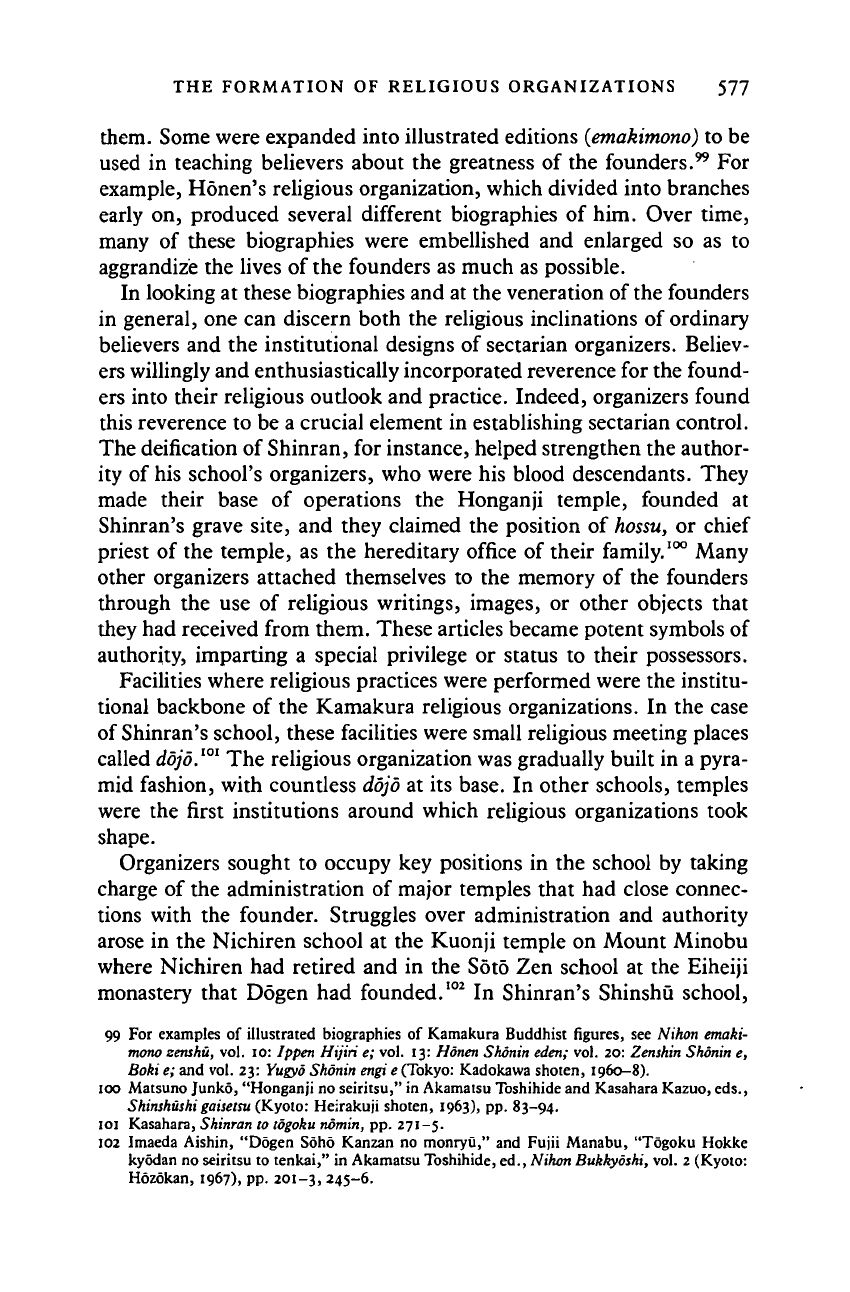
THE FORMATION OF RELIGIOUS ORGANIZATIONS 577
them. Some were expanded into illustrated editions (emakimono) to be
used in teaching believers about the greatness of the founders.
99
For
example, Honen's religious organization, which divided into branches
early on, produced several different biographies of him. Over time,
many of these biographies were embellished and enlarged so as to
aggrandize the lives of the founders as much as possible.
In looking at these biographies and at the veneration of the founders
in general, one can discern both the religious inclinations of ordinary
believers and the institutional designs of sectarian organizers. Believ-
ers willingly and enthusiastically incorporated reverence for the found-
ers into their religious outlook and practice. Indeed, organizers found
this reverence to be a crucial element in establishing sectarian control.
The deification of Shinran, for instance, helped strengthen the author-
ity of his school's organizers, who were his blood descendants. They
made their base of operations the Honganji temple, founded at
Shinran's grave site, and they claimed the position of
hossu,
or chief
priest of the temple, as the hereditary office of their family.
100
Many
other organizers attached themselves to the memory of the founders
through the use of religious writings, images, or other objects that
they had received from them. These articles became potent symbols of
authority, imparting a special privilege or status to their possessors.
Facilities where religious practices were performed were the institu-
tional backbone of the Kamakura religious organizations. In the case
of Shinran's school, these facilities were small religious meeting places
called dojo.
101
The religious organization was gradually built in a pyra-
mid fashion, with countless dojo at its base. In other schools, temples
were the first institutions around which religious organizations took
shape.
Organizers sought to occupy key positions in the school by taking
charge of the administration of major temples that had close connec-
tions with the founder. Struggles over administration and authority
arose in the Nichiren school at the Kuonji temple on Mount Minobu
where Nichiren had retired and in the Soto Zen school at the Eiheiji
monastery that Dogen had founded.
102
In Shinran's Shinshu school,
99 For examples of illustrated biographies of Kamakura Buddhist figures, see Nihon emaki-
mono
zenshu,
vol. 10: Ippen Hijiri e; vol. 13:
Honen
Shonin eden; vol. 20: Zenthin
Shonin
e,
Boki
e;
and vol. 23:
Yugyo
Shonin
engi
e (Tokyo: Kadokawa shoten, 1960-8).
100 Matsuno Junko, "Honganji no seiritsu," in Akamatsu Toshihide and Kasahara Kazuo, cds.,
Shinshushi gaisetsu
(Kyoto: Heirakuji shoten, 1963), pp. 83-94.
101 Kasahara, Shinran
10 togoku
nomin,
pp. 271-5.
102 Imaeda Aishin, "Dogen Soho Kanzan no monryu," and Fujii Manabu, "Togoku Hokke
kyodan no seiritsu to tenkai," in Akamatsu Toshihide, ed., Nikon Bukkyoshi, vol. 2 (Kyoto:
Hozokan, 1967), pp. 201-3, 245-6.
Cambridge Histories Online © Cambridge University Press, 2008
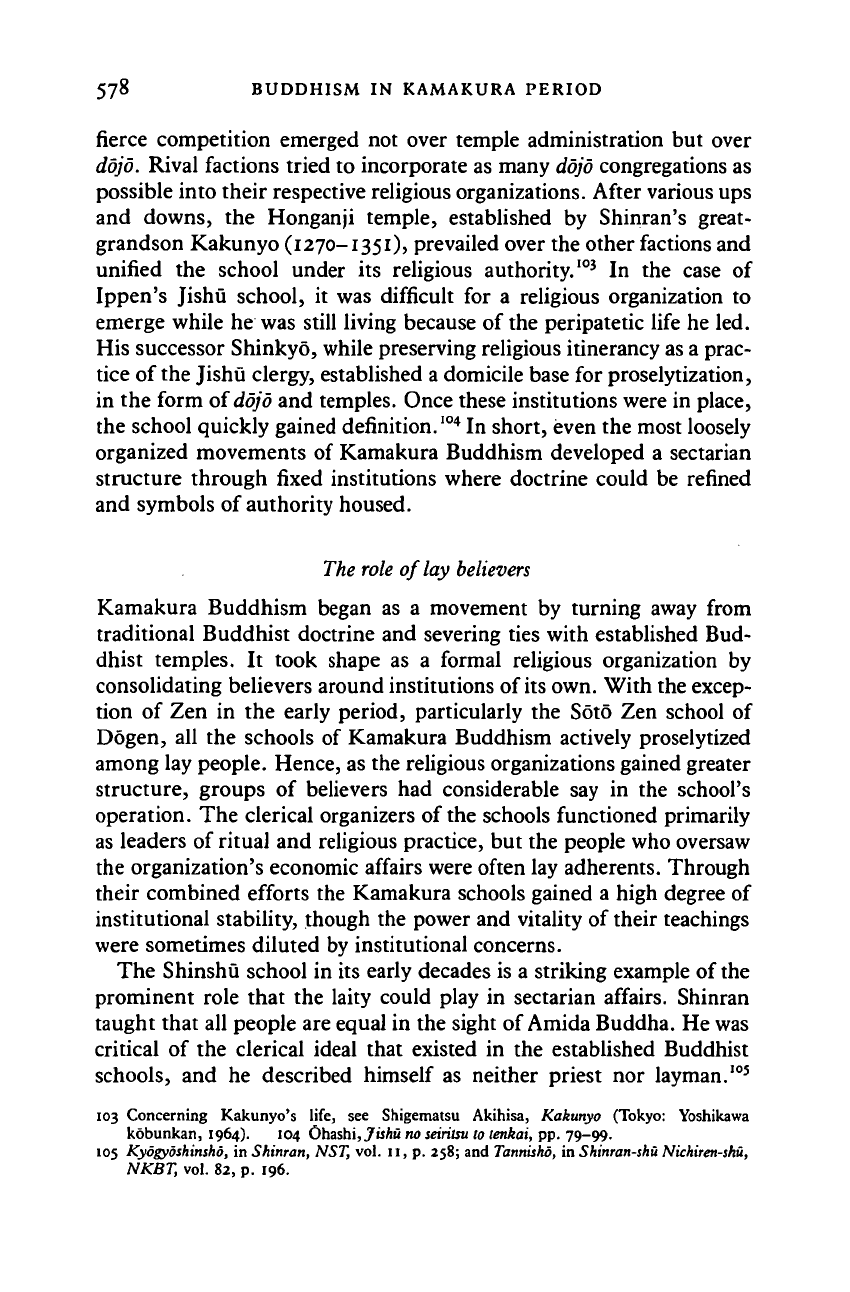
578 BUDDHISM IN KAMAKURA PERIOD
fierce competition emerged not over temple administration but over
dojo.
Rival factions tried to incorporate as many
dojo
congregations as
possible into their respective religious organizations. After various ups
and downs, the Honganji temple, established by Shinran's great-
grandson Kakunyo (1270-1351), prevailed over the other factions and
unified the school under its religious authority.
103
In the case of
Ippen's Jishu school, it was difficult for a religious organization to
emerge while he was still living because of the peripatetic life he led.
His successor Shinkyo, while preserving religious itinerancy as a prac-
tice of the Jishu clergy, established a domicile base for proselytization,
in the form of
dojo
and temples. Once these institutions were in place,
the school quickly gained definition.
104
In short, even the most loosely
organized movements of Kamakura Buddhism developed a sectarian
structure through fixed institutions where doctrine could be refined
and symbols of authority housed.
The
role
of lay
believers
Kamakura Buddhism began as a movement by turning away from
traditional Buddhist doctrine and severing ties with established Bud-
dhist temples. It took shape as a formal religious organization by
consolidating believers around institutions of its own. With the excep-
tion of Zen in the early period, particularly the Soto Zen school of
Dogen, all the schools of Kamakura Buddhism actively proselytized
among lay people. Hence, as the religious organizations gained greater
structure, groups of believers had considerable say in the school's
operation. The clerical organizers of the schools functioned primarily
as leaders of ritual and religious practice, but the people who oversaw
the organization's economic affairs were often lay adherents. Through
their combined efforts the Kamakura schools gained a high degree of
institutional stability, though the power and vitality of their teachings
were sometimes diluted by institutional concerns.
The Shinshu school in its early decades is a striking example of the
prominent role that the laity could play in sectarian affairs. Shinran
taught that all people are equal in the sight of Amida Buddha. He was
critical of the clerical ideal that existed in the established Buddhist
schools, and he described himself as neither priest nor layman.
105
103 Concerning Kakunyo's life, see Shigematsu Akihisa, Kakunyo (Tokyo: Yoshikawa
kobunkan, 1964). 104 Ohashi, Jishu
no seiritsu
to tenkai, pp. 79-99.
105 Kyogyoshinsho, in Shinran, NST, vol. 11, p. 258; and
Tannisho,
in
Shinran-shu
Nichiren-shu,
NKBT,
vol. 82, p. 196.
Cambridge Histories Online © Cambridge University Press, 2008
